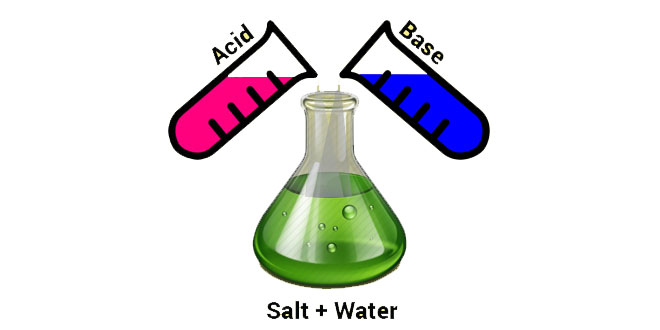Question: You have been provided with three test tubes. One of them contains distilled water and the other two contain an acidic solution and a basic solution respectively. If you are given only red litmus paper, how will you identify the contents of each test tube?
Answer: The contents of each test tube would be identified by change in colour of red litmus paper. For example, when we wet the red litmus paper with the basic solution, it changes into blue colour. Put the changed blue litmus paper in the solution which turns the blue to red will be the acidic solution. The solution, which has no effect on any litmus paper, will be neutral and hence it will be distilled water.
Question: Why should curd and sour substances not be kept in brass and copper vessels?
Answer: Curd and other sour foodstuffs contain acids, which can react with the metal of the vessel to form poisonous metal compounds which can cause food poisoning and damage our health.
Question: Which gas is usually liberated when an acid reacts with a metal? Illustrate with an example. How will you test for the presence of this gas?
Answer: When a metal reacts with an acid, usually hydrogen gas is liberated.
Reason: Metals loose electrons easily and thus can reduce hydrogen ions (H+) of an acid to hydrogen gas.
e.g., when zinc reacts with dilute sulphuric acid, it produces hydrogen gas.
Test: The hydrogen gas evolved can be tested by passing the gas through soap solution and then bringing a burning candle near a gas filled bubble.
Result: The soap bubble bursts and the hydrogen gas burns with a pop sound.
Question: Metal compound A reacts with dilute hydrochloric acid to produce effervescence. The gas evolved extinguishes a burning candle. Write a balanced chemical equation for the reaction if one of the compounds formed is calcium chloride.
Answer: The gas that extinguishes a burning candle is carbon dioxide, which is formed by the action of dilute hydrochloric acid on a metal carbonate and produces effervescence. Now, since one of the compounds formed is calcium chloride, it shows that the metal compound is calcium carbonate. Thus, the metal compound A is calcium carbonate (CaCO3). Calcium carbonate reacts with dilute hydrochloric acid to form calcium chloride, carbon dioxide and water. This can be written as.
Question: Why do HCl, HNO3, etc., show acidic characters in aqueous solutions while solutions of compounds like alcohol and glucose do not show acidic character?
Answer: An acid is a substance, which dissociates on dissolving in water to produce hydrogen ions [H+(aq) ions]. The acids like HCl, H2SO4, HNO3 and CH3COOH, etc., show acidic character because they dissociate in aqueous solutions to produce hydrogen ions, H+(aq) ions.
The compounds such as glucose and alcohol also contain hydrogen but they do not show acidic character. The aqueous solutions of glucose and alcohol do not show acidic character because the hydrogen in them does not separate out as hydrogen ions [H+ (aq) ions] on dissolving in water.
Question: Why does an aqueous solution of acid conduct electricity?
Answer: The aqueous solution of an acid conducts electricity due to the presence of charged particles called ions in it.
Question: Why does dry HCl gas not change the colour of the dry litmus paper?
Answer: Dry HCl gas does not contain any hydrogen ions in it, so it does not show acidic behavior. In fact, dry HCl gas does not change the colour of dry litmus paper as it has no hydrogen ions [H+(aq) ions] in it.
Question: While diluting an acid, why is it recommended that the acid should be added to water and not water to the acid?
Answer: Diluting an acid should be done by adding concentrated acid to water gradually with stirring and not by adding water to concentrated acid.
The heat is evolved gradually when a concentrated acid is added to water for diluting an acid and the large amount of water is easily absorbed.
If, however, water is added to concentrated acid to dilute it, a large amount of heat is evolved at once. The heat generated may cause the mixture to splash the acid on our face or clothes and cause acid burns.
Question: How is the concentration of hydronium ions (H3O+) affected when a solution of an acid is diluted?
Answer: When the concentrated solution of an acid is diluted by mixing water, the concentration of hydronium ions H3O+ per unit volume decreases.
Question: How is the concentration of hydroxide ions (OH-) affected when excess base is dissolved in water?
Answer: When the solution of a base is diluted by mixing more water in it, the concentration of hydroxide ions (OH– ions) per unit volume decreases.
Question: You have two solutions A and B. The pH of solution A is 6 and pH of solution B is 8.
i. Which solution has more hydrogen ion concentration?
ii. Which of this is acidic and which one is basic?
Answer: The pH of a solution is inversely proportional to its hydrogen ion concentration. This means that the solution having lower pH will have more hydrogen ion concentration. In this case, solution A(having a lower pH of 6) will have more hydrogen ion concentration.Solution A is acidic and solution B is basic.
Question: What effect does the concentration of H+(aq) ions have on the nature of the solution?
Answer: Acids produce hydrogen ions in water. So, when an acid is added to water, the concentration of hydrogen ions in water increases. The solution of acid thus formed will have more of hydrogen ions and it will be acidic in nature.
 Class Notes NCERT Solutions for CBSE Students
Class Notes NCERT Solutions for CBSE Students






